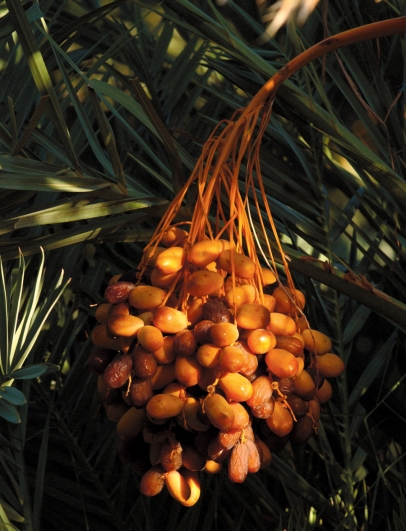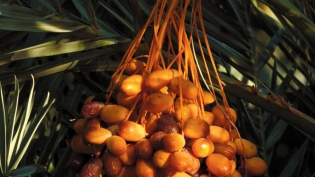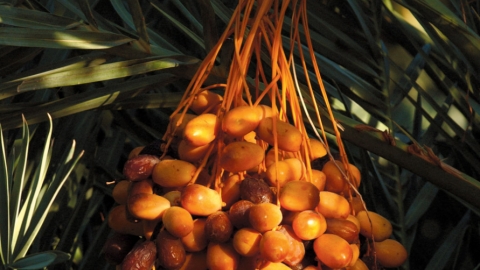What's in Season: California Dates
Dates have long been associated with the holidays—savory stuffed and bacon-wrapped dates, date bars, date cakes and breads, date cookies and date candies—no doubt partially because they come into their full season during the last months of the year. A personal favorite way of preparing dates is stuffing them with almonds, which my grandmother served every December.
Dates are the edible fruit of the date palm tree. They are thought to have originated in the Middle East, but they have been cultivated for so long and so widely, wherever growing conditions are amenable, that no one has been able to trace their history back to the first wild trees. Date palms thrive in dry, hot climates where lots of water is available to their roots, the kind of conditions that are found in the southern and eastern Mediterranean, the Middle East and parts of the southwestern United States, in particular the extreme southern reaches of California and parts of Arizona.
Date palms were first grown in Southern California’s Coachella Valley in 1890, but the commercial success of California’s dates really began with a man named Walter Swingle. Swingle was hired in 1898 by the USDA as part of a new plant explorer initiative. The mission of this group was to travel the world and bring back plants and seeds to try out in the United States in an effort to introduce new, commercially viable agricultural crops.
While visiting Algeria in 1904, Swingle procured Deglet Noor suckers which he thought would do well in the desert climates of the American Southwest and sent a large shipment to the Heber Agricultural Station in California’s Imperial Valley. A few years later he sent another large shipment to another station in Mecca, in California’s Coachella Valley.
By 1921, California dates had become such a thriving industry that a festival was inaugurated in Riverside County to celebrate the crop. The festival had an Arabian Nights theme and visitors came from all over to see the date palms and exotic festivities and to taste date-filled foods. The Riverside County Fair and National Date Festival continues today with highlights including a “Queen Scheherazade” pageant and camel races, among other “Arabian” notes. This winter’s festival will take place February 16–25.
A few years ago I visited Leja Family Farms in Coachella, which comes north to many of our local farmers’ markets to sell their Medjool, Deglet Noor and Barari dates. It was just coming up on the fall harvest season, and as my friend and I approached the farm we were surrounded by groves of tall palms loaded with hanging bunches of dates, most of them wrapped in brown paper cones, some in what appeared to be muslin bags. The trees were planted in dusty, sandy soil that blew in thin drifts across the road. It was easy to understand why early visitors in the 1920s and ’30s thought they were visiting Arabia, which was part of the marketing scheme of the era, a time when Americans were entranced by Hollywood films such as Rudolph Valentino’s The Sheik and One Thousand and One Arabian Nights.
Leja Family Farms is just one of many date farms in the Coachella and Imperial Valley today, and the region’s datefarming belt now stretches into Arizona, as well. Most of the dates farmed are of three main varieties. The Deglet Noor is considered the queen of dates: dark, smooth and medium-sized. The Medjool is larger: a dark honey-caramel color and super-sweet. The Barari is relatively small, also very sweet, and a light golden brown.
Culinarily, the date varieties can be used interchangeably, but on a bite-by-bite basis, eating out of hand, you’ll find differences in flavor. Dates are especially suited to pairing with savories such as bacon, cheese and nuts, and this makes them versatile for holiday appetizers, while their natural sweetness makes them ideal to use in confections.







